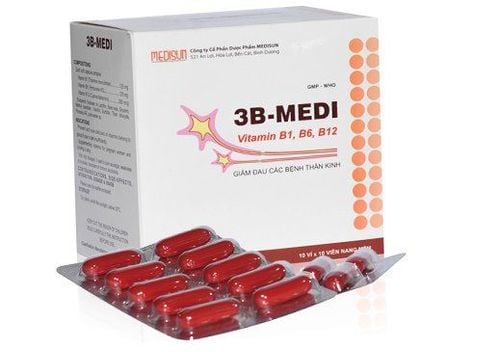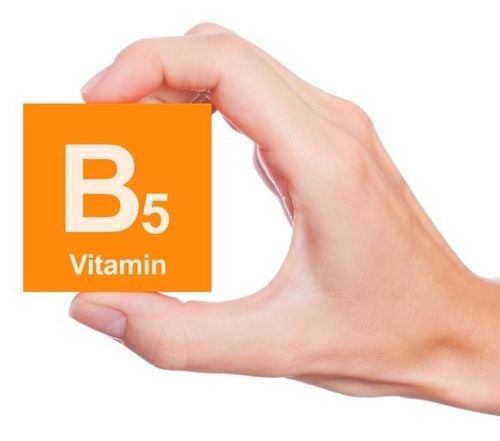This is an automatically translated article.
Phacoparamol is a combination drug used to support the symptomatic treatment of infectious or allergic diseases in the respiratory tract. The drug can be used to treat symptoms for both children over 6 years old and adults.
1. What is Phacoparamol?
What is Phacoparamol? Phacoparamol has the main ingredient Paracetamol 325 mg; Chlorpheniramine maleate 2 mg; Vitamin B1 10mg and excipients. Prepared in the form of effervescent powder sachets.
Paracetamol (acetaminophen or N - acetyl - p - aminophenol) is an active metabolite of phenacetin, which is an effective analgesic and antipyretic that can replace aspirin. However, unlike aspirin, paracetamol is not effective in treating inflammation. In equal doses in grams, paracetamol has analgesic and antipyretic effects similar to aspirin. Drugs lower body temperature in hyperthermia, but do not cause hypothermia in normal body temperature.
Chlorpheniramine is an H1 antihistamine. The antihistaminic effect of chlorpheniramine is through the mechanism of competitive blockade of the H1 receptor of cells, thereby preventing histamine from binding to the receptor and reducing inflammatory symptoms. Like most antihistamines, chlorpheniramine also has anticholinergic side effects, which often vary widely between individuals.
2. Indications and contraindications of the drug Phacoparamol
2.1.Indications Phacoparamol is used in the following cases:
Fever, headache, muscle aches, joint pain caused by flu, cold. Support for symptomatic treatment of upper respiratory tract infections causing sneezing, watery eyes, stuffy nose, runny nose, chills; relieve symptoms of sinusitis caused by bacteria or weather, allergic rhinitis. 2.2.Contraindications Do not use Phacoparamol in the following cases:
Patients with severe liver or kidney failure. Hypersensitivity to any ingredient of Phacoparamol. The patient is having an acute asthma attack. Patients with deficiency of glucose-6 - phosphate dehydrogenase (G6PD) Patients with symptoms of prostate enlargement; bladder neck obstruction; Narrow angle glaucoma. Patients taking monoamine oxidase inhibitors (MAOIs) within 14 days, up to the time of treatment with chlorpheniramine. Because the anticholinergic properties of chlorpheniramine are enhanced when co-administered with MAO inhibitors.
3. Dosage and how to use Phacoparamol
How to use: Phacoparamol is prepared in the form of effervescent powder. When using, it is necessary to dissolve the drug in the appropriate amount of water until the foam is gone. Accordingly, the patient should use it as soon as the foam is gone. The interval between doses is 4-6 hours and should not exceed 5 times/day.
Dosage:
Children from 6 to 12 years old: Mix 1 sachet (Paracetamol 325 mg; Chlorpheniramine maleate 2 mg) / time. Adults and children over 12 years old: Mix 1.5 sachets (Paracetamol 325mg; Chlorpheniramine maleate 2mg)/time. Treatment of overdose:
Paracetamol overdose can occur after a single high dose, or from repeated high doses of Paracetamol (7.5 - 10g daily, for 1-2 days). or due to taking the usual medicine but for a long time. Acute liver necrosis is the most serious acute toxic effect of overdose and can be fatal if not treated promptly. Nausea, vomiting, and abdominal pain usually occur within 2 to 3 hours after a person takes a high dose of the drug, and then there may be jaundice, even coma. Overdose of Chlorpheniramine causes central nervous system stimulation, seizures, convulsions, respiratory arrest (the lethal dose of Clopheniramine is about 25-50 mg/kg body weight). The treatment method is to carry out gastric lavage in all cases, preferably within 4 hours after ingestion and active supportive treatment. Use antidotes such as N-acetylcysteine, Methionine, induce vomiting with syrup ipecacuanha. Monitoring and supportive symptomatic treatment are necessary when treating paracetamol overdose.
4. Phacoparamol side effects
Possible side effects when taking the drug include:
Skin rash and other possible allergic reactions. Usually erythema or urticaria, but occasionally can be more severe and may be accompanied by drug fever and mucosal lesions. In rare cases, paracetamol has caused neutropenia, thrombocytopenia and possibly pancytopenia. Uncommon: Nausea, vomiting, somnolence to deep sleep, dry mouth, dizziness, profuse sweating, hematopoiesis (neutropenia, causing pancytopenia, leukopenia), anemia , acute kidney disease, nephrotoxicity are often seen with long-term abuse. Rare: Hypersensitivity reactions; Paracetamol may cause serious skin reactions such as Stevens-Johnson syndrome (SJS), toxic epidermal necrolysis or Lyell's syndrome or acute generalized exanthematous pustulosis (AGEP). ); Vitamin B1-induced acute hypertension. When used as directed, it is usually quite safe. However, if any adverse reactions occur, you should stop taking the medicine and consult your doctor or pharmacist.
5. Note when using Phacoparamol
Paracetamol is relatively safe and non-toxic at therapeutic doses, however, some patients may have other reactions such as itching, urticaria, and hypersensitivity. In particular, when abused or used concurrently with other drugs with the same ingredients may increase the risk of hepatotoxicity. The use of Phacoparamol may increase the risk of respiratory complications, respiratory failure and apnea, which may be detrimental in people with obstructive pulmonary disease or in young children. Care must be taken when used for people with chronic lung disease, shortness of breath or difficulty breathing, children, the elderly. Patients are at risk of tooth decay when taking Phacoparamol for a long time, because of the anti-acetylcholine effect that causes dry mouth. Therefore, patients need to take care of their teeth regularly. Drinking a lot of alcohol can increase the hepatotoxicity of paracetamol, so patients should avoid or limit alcohol consumption. For pregnant and lactating women: Phacoparamol is only used for pregnant and lactating women when absolutely necessary. It should be used under the direction of a doctor. Be careful when driving and operating machines, because the drug can cause drowsiness, drowsiness and affect the ability to concentrate. Drug interactions:
Isoniazid, anticonvulsants (Phenytoin, Barbiturates, Carbamazepine) may increase the risk of hepatotoxicity caused by Paracetamol. Co-administration of Phenothiazines with Paracetamol can lead to the potential for severe hypothermia. Metoclopramide may increase the absorption of Paracetamol, increasing the risk of overdose. Alcohol and sedatives that induce sleep may increase the CNS depressant effects of clopheniramine. Clopheniramine inhibits the metabolism of the drug Phenytoin and can lead to Phenytoin toxicity. Store the medicine in a cool, dry place, out of direct sunlight and out of the reach of children.
Hope with the above information you know what the drug Phacoparamol is and how to use it. If you have any questions during use, ask your doctor or pharmacist for advice.
Follow Vinmec International General Hospital website to get more health, nutrition and beauty information to protect the health of yourself and your loved ones in your family.
Please dial HOTLINE for more information or register for an appointment HERE. Download MyVinmec app to make appointments faster and to manage your bookings easily.













